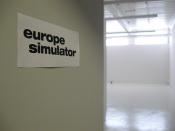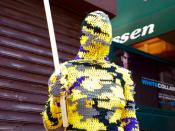-Roy Lichtenstein was an American pop art painter, graphic artist, and sculptor, and he was best known for his comic-strip art. He worked starting from the late 1930's to 1997.
Roy Lichtenstein was born in New York City in 1923. In 1939- 1940 he studied under Reginald Marsh at the Art Students' League, New York, and 1940-1943 at Ohio State University, Columbus, where he completed his studies with an M.A.(Master of Fine Arts). Between those two periods of study he did his military service in Europe. Between 1949 and 1951 he taught at Ohio University. In 1951 he had his first one-man exhibition at the Carlebach Gallery, New York. Until 1957 he worked as a commercial artist and designer and did display work for shop windows. His paintings and drawings at this time were of American twenties' art. From 1957 to 1960 he taught at New York State University, Oswego, New York.
His work passed through an Abstract-Expressionist phase. In 1960 he began to use typical elements of commercial art, comics, and advertisements in his drawings and paintings. From 1960-1963 he taught at Douglas College, Rutgers University, New York. In 1965 he had a one-man exhibition at the Leo Castelli Gallery, New York. In 1963 he moved back to New York. He was commissioned by the architect Philip Johnson to produce large format paintings for the New York State Pavilion at the World's Fair in New York and had his first one-man exhibition in Europe at the Galerie Ilenia Sonnabend, Paris. He was given his first American retrospective exhibition at the Modern Museum of Art, Clevland. In 1967-1968 he had a retrospective at the Pasadena Art Museum, also shown at Minneapolis, Amsterdam, London, Berne, and Hanover. In 1969 he was given a retrospective at the Solomon R.
Guggenheim Museum, New York. he had a retrospective of his drawings in 1975 at the Centre National d'Art Contemporian, Paris, also shown at Berlin.
In 1979 he received his first public commission for a sculpture. He made the Mermaid for the Theater of the Performing Arts, Miami beach, Florida. he painted the series American Indians. In 1981 the St. Louis Art Museum organized a retrospective of his work which toured the USA, Europe and Japan. In 1982 he rented a loft in New York in addition to his studio in Southampton. In 1985 he produced a mural for the Equitable Center, New York. In 1987 he had a retrospective of his drawings at the Museum of Modern Art, new York, and at the Kunsthalle, Frankfurt, in 1988. In September of 1997 Roy Lichtenstein died of pneumonia.
Roy Lichtenstein's art work was fascinating. When he first began to draw he drew comic-strips. The comic-strip paintings such as The Melody Haunts my Reverie, and Good Morning, Darling, are blowups of the original cartoon characters, reproduced by hand, with the same technique of benday dots and bright primary colors used in printing. His later works include reproductions of popular-romance characters, stylized landscapes, picture- postcards of classical temples and showed the influence of Henri Matisse and Pablo Picasso. His sculptures also re-create comic-strip effects. He had produced ceramic works as well.
Roy Lichtenstein was and still is famous for many paintings, drawings and sculptures. Some of the paintings he is famous for are Good Morning, Darling(1964), The Melody Haunts My reverie(1965), I Know...
Brad(1963), The Statue of Liberty(1963), and the one I have researched on named Stepping Out(1978).
Stepping Out was made in 1978 by Roy Lichtenstein. Stepping out is now shown at the Metropolitan Museum of Art. I went there and looked at the painting Stepping Out. I looked at it carefully and I noticed that it was made up of benday dots around the faces. The dots were perfectly spherical. The majority of the background is solid black in color and the other part is an off white color. The dark background makes the characters stand out more and catches the eye of the person looking at the painting. Roy Lichtenstein also uses bright primary colors in this printing. The left side of the painting reminds me of Pablo Picasso's work because the character is messed up. It looks as if it is supposed to be a girl but it only has one eye which is vertically placed instead of horizontally, no nose, a mouth halfway made up of dots, and a rectangular face. Although the man on the right side of the painting looks normal. He looks very serious. He also has a yellow rectangular figure going across his eyes. I think this painting is very interesting because it shows in great detail how you can change subject matter, using themes as diverse as cartoons.
I enjoyed researching on Roy Lichtenstein because it gave me a great lesson on how you can change the way things are in society and turn them into such themes as cartoons. I admire that Roy Lichtenstein brilliantly proclaimed the comic-strip as a fitting theme for the new American painting of the 1960s.+


